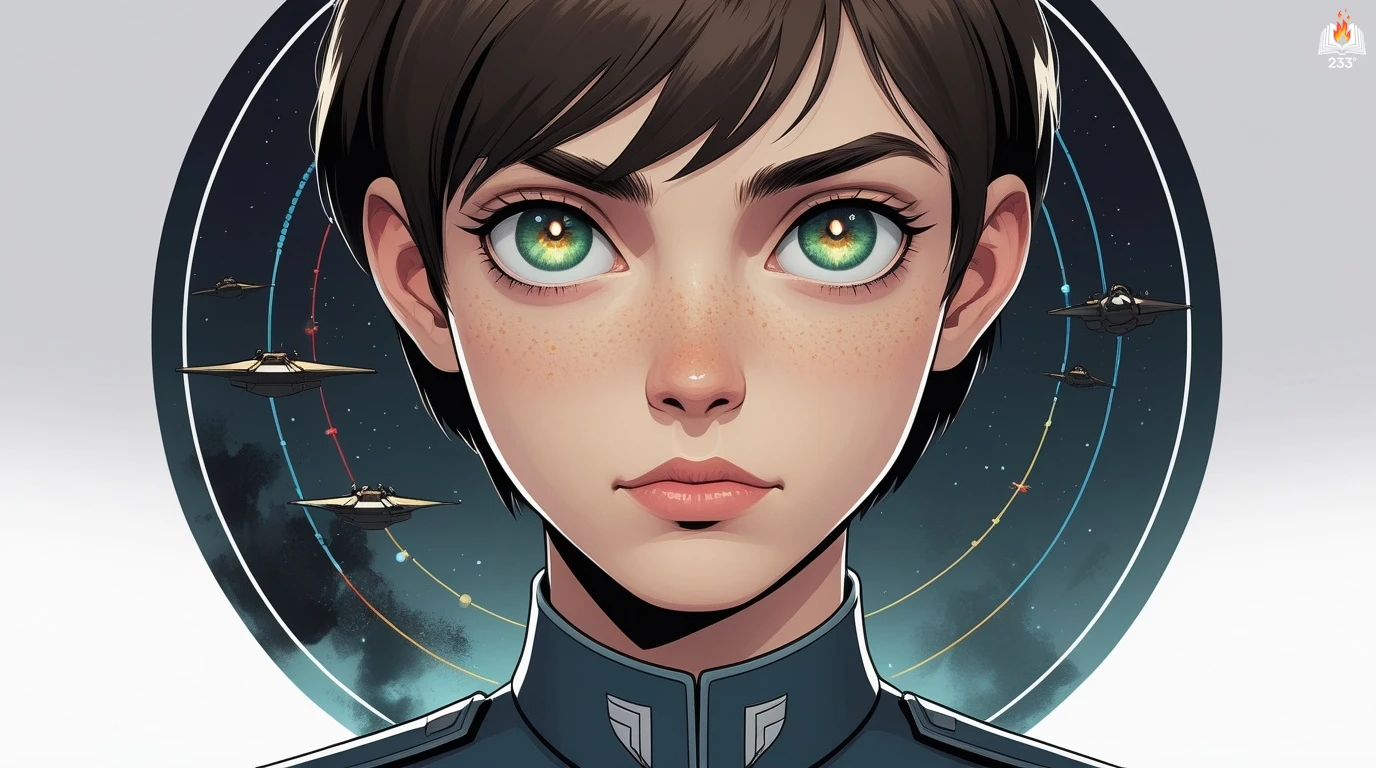Shadows in Flight by Orson Scott Card, published in 2011, is part of the acclaimed Ender’s Game series, specifically following the Shadow Saga arc. This novel continues the story of Bean (Julian Delphiki) and his genetically enhanced children as they voyage aboard the starship Herodotus, racing against time and genetics to find a cure for their fatal condition.
Plot Summary
Aboard the starship Herodotus, the vast emptiness of space stretched beyond the hull as Julian “Bean” Delphiki watched his children grow, their minds as brilliant as his own, their bodies racing toward destruction. Anton’s Key, the genetic gift and curse unlocked in their DNA, had granted them genius but sentenced them to relentless physical growth and a short life. Time on Earth moved eighty-five times faster than on the ship, but for Bean and his three children – Ender, Carlotta, and Cincinnatus, nicknamed Sergeant – time was slipping through their fingers.
Ender, the calm analyst, poured over genetic models, searching desperately for a cure that would save them from Anton’s syndrome. Carlotta, the ship’s engineer and emotional heart, maintained the systems, ensured stability, and tried to keep the peace. Sergeant, the restless warrior, simmered with ambition and frustration, yearning for importance and chafing against his siblings’ leadership. Bean, confined to the cargo hold by his giant body, could only watch as his children faced the same fate he had long feared.
Life aboard the Herodotus was a delicate dance of duty and conflict. When Sergeant’s growing impatience erupted in a tense confrontation over Bean’s looming death, it shattered the uneasy balance. Ender, usually the quiet peacekeeper, surprised even himself when he turned on Sergeant, making it clear that the days of unchecked dominance were over. Bean, observing from his massive confinement, felt both sorrow and a flicker of hope. He had dreamed of giving his children a future. Now, with his own end drawing near, all he could do was prepare them to survive without him.
While the siblings struggled to find their footing, the universe intervened. Carlotta, combing through star charts and gravitational data, detected an anomaly: a massive object, not a natural body, moving with purpose. It was a ship, ancient and colossal, slowing as it approached a planet nestled in a star’s goldilocks zone. Humanity had encountered only one alien species before – the Formics, long presumed extinct. Yet as Carlotta’s scans confirmed, this vessel bore unmistakable Formic markings.
The siblings faced a choice. To flee and leave behind the mystery, or to stay and uncover what remained of the Formic legacy. Bean, though weakened, knew the answer. Carlotta would lead the deceleration and approach. Ender would continue his work on the genetics puzzle. And Sergeant, finally given a mission worthy of his ambition, would prepare the Herodotus for any threat. For the first time in his young life, Sergeant’s talents were indispensable.
As the Herodotus closed in, the siblings launched the small maintenance craft, the Puppy, toward the Formic ship. Sergeant took the helm, skimming across the alien hull to an airlock. Clad in a pressure suit, he ventured inside. His discovery was sobering – a dark, quiet warren, no welcoming party, no guards. But the silence was deceiving. Within moments, small, crablike creatures burst from the shadows. Sergeant fought his way out, seizing one specimen for study as he escaped. Back aboard the Herodotus, Ender examined the creature, uncovering traces of Formic DNA – they were not merely pests, but the genetically reshaped descendants of the Hive Queen’s own kind.
Driven by urgency and curiosity, the siblings prepared for a deeper expedition. Bean, too large to join, entrusted them with a mission that balanced exploration with survival. Ender, though reluctant, agreed to accompany Carlotta and Sergeant, drawn by the lure of genetic knowledge hidden in the ship’s decaying systems.
Inside the Formic vessel, the trio moved carefully, their boots magnetized to the unfamiliar surfaces. They traced the old tracks of maintenance trams, navigated past carcasses both alien and familiar, and followed the trail toward the ship’s heart. Along the way, they encountered the rab-like creatures – fierce but unsophisticated, perhaps once tools, now feral remnants of a collapsed civilization. With sedatives and strategy, the siblings pressed forward, each step revealing the tragic grandeur of the ship.
At the core, they reached what could only be called the throne room. A cavernous space, lined with decaying egg chambers and filled with the stench of rot. There, cradled in the center, lay the withered, winged body of a Hive Queen, long dead but still the gravitational center of the ship’s silent society. The children gathered around, absorbing the magnitude of what they saw. Ender collected samples with a careful hand, his mind racing with possibilities. Carlotta and Sergeant watched the shadows, alert to every scuttle and twitch.
Even in death, the Hive Queen’s influence lingered. Systems still ran. Maintenance trams moved. And somewhere within the labyrinth, tasks continued as if awaiting her next command. The siblings speculated – had she prepared some workers to survive without her? Had she broken the fatal link between queen and colony? If the Formics had discovered such a secret, it might hold the key to saving the Delphiki family from their own genetic doom.
The exploration deepened. In the dark tunnels, the trio found chambers of purpose – feeding systems, storage holds, control nodes. They witnessed the grim efficiency of the rabs as they herded slugs into nutrient chambers, sustaining a machine without a mind. Each discovery layered new questions onto the old war between species, the war humanity thought it had ended.
The path eventually led them to a central helm, a space humming with dormant power. It was clear now – the Formic ship had not merely drifted into this system. It had arrived, guided with intent, slowed by hands or minds still at work. Somewhere, buried in the ship’s depths, survivors waited. Whether friend or foe, no one yet knew.
Outside the ark of alien memory, Bean listened through the intercom, his heart heavy. He had given his children over to history, to danger, to the unknown. But in this moment, watching them step forward together – the patient thinker, the steadfast engineer, the reckless soldier – he felt a measure of peace. The fate he could never outrun had given him one final victory: his children were no longer just brilliant outcasts racing toward death. They were explorers, pioneers, perhaps even saviors.
The journey was far from over. Ahead waited new questions, new alliances, perhaps new wars. But aboard the Herodotus, for the first time in years, there was more than just survival. There was purpose.
Main Characters
Julian “Bean” Delphiki: The legendary strategist and former companion of Ender Wiggin, Bean is a giant both in body and intellect due to Anton’s Key, a genetic alteration that grants genius-level intelligence but causes unchecked physical growth. In Shadows in Flight, Bean is a dying father, consumed by guilt, love, and determination to secure a future for his children before his body fails.
Ender Delphiki (named after Ender Wiggin): Bean’s son, a brilliant thinker with a calm, analytical mind. Ender is deeply invested in finding a genetic cure for Anton’s Key, often isolating himself in research. He is a natural leader when needed but carries the burden of their impending mortality with quiet resolve.
Carlotta Delphiki: The most pragmatic and technically skilled of Bean’s children, Carlotta is practical, empathetic, and often mediates between her combative brothers. She handles much of the ship’s operations and acts as the emotional anchor of the group.
Cincinnatus “Sergeant” Delphiki: The most aggressive and militaristic sibling, Sergeant craves action, command, and validation. He struggles with feelings of being overshadowed and often seeks dominance, creating tension among the trio. His arc is marked by an internal struggle between fear and courage.
Theme
Genetic Destiny vs. Free Will: The novel wrestles with the question of whether the children’s futures are sealed by their biology or if they can overcome fate through ingenuity, love, and sacrifice. This tension propels both the scientific efforts and interpersonal conflicts aboard the Herodotus.
Isolation and Family: Aboard a ship hurtling through space, the Delphikis grapple with profound loneliness and the unique, sometimes claustrophobic bonds of family. Their survival depends as much on their emotional resilience as on their scientific breakthroughs.
The Burden of Leadership: Bean and his children face the constant pressure of leadership, decision-making, and moral responsibility. Whether it’s Bean’s paternal oversight or Ender’s and Sergeant’s clash over command, the novel probes the cost of authority.
The Legacy of the Formics: The encounter with the derelict Formic ship revives themes from the Ender saga — fear of the alien, the consequences of xenocide, and the possibility of reconciliation or understanding beyond war.
Writing Style and Tone
Orson Scott Card’s prose in Shadows in Flight balances intellectual rigor with emotional immediacy. He seamlessly interweaves technical detail about genetics, space travel, and military tactics with intimate portraits of characters wrestling with love, fear, and mortality. Card’s language is accessible yet layered, allowing readers to engage with scientific and moral complexities without being overwhelmed.
The tone of the novel oscillates between tension and tenderness. Moments of familial squabbling, dark humor, and sharp dialogue contrast with stretches of meditative sorrow and philosophical musing. Card employs a close third-person narrative that shifts perspectives fluidly among characters, granting readers intimate access to their interior struggles. The atmosphere is taut with the urgency of survival but softened by deep familial connection, lending the novel both suspense and heart.
We hope this summary has sparked your interest and would appreciate you following Celsius 233 on social media:
There’s a treasure trove of other fascinating book summaries waiting for you. Check out our collection of stories that inspire, thrill, and provoke thought, just like this one by checking out the Book Shelf or the Library
Remember, while our summaries capture the essence, they can never replace the full experience of reading the book. If this summary intrigued you, consider diving into the complete story – buy the book and immerse yourself in the author’s original work.
If you want to request a book summary, click here.
When Saurabh is not working/watching football/reading books/traveling, you can reach him via Twitter/X, LinkedIn, or Threads
Restart reading!








